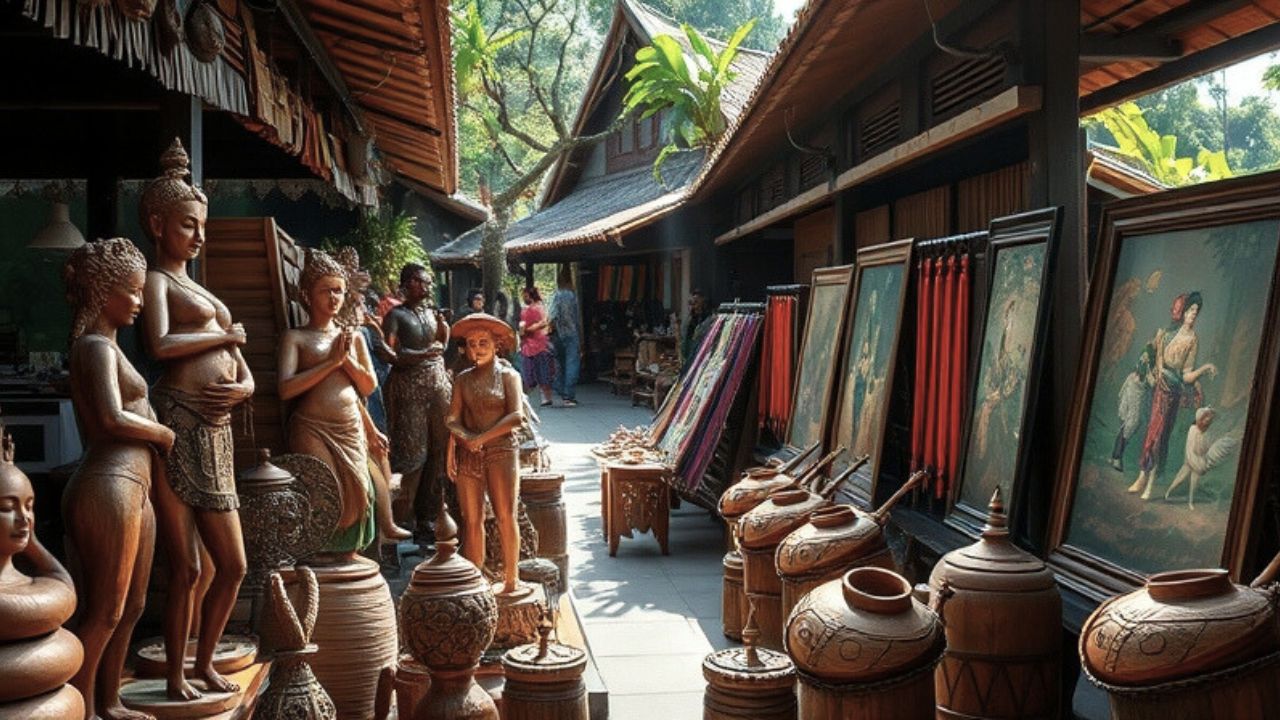The Harmony of Balinese Art and Culture in Everyday Life

In Bali, art and culture aren’t something you find stored away or tucked out of sight, they’re everywhere, part of the rhythm of daily life. It’s in the hands of a carver shaping a piece of wood into something sacred, in the steady gaze of a jeweler coaxing silver into a story, and in the vivid patterns of a fabric that seems to hum with energy. Here, Balinese art and culture aren’t just acts of creation, they’re a way of being.
The Craft of Wood
Walk into any village, and you’ll notice the rhythm of hands at work, chisels on wood, looms clicking softly, brushes dancing over canvas. In Mas, a village renowned for its woodcarving tradition, artisans create everything from intricate statues of deities to elaborately carved doors and furniture. These works aren’t just decorative, they’re deeply spiritual. Each piece reflects stories from Balinese mythology, Hindu epics, or local folklore. Visitors can even join workshops in Mas to learn about the techniques and symbolism behind this traditional craft, offering a hands-on connection to Balinese art and culture.
Silver Stories
In Celuk, just a short drive from Ubud, silver workshops hum with quiet precision. Artisans here craft intricate jewelry, ceremonial items, and home décor from silver and gold. The designs often include nature-inspired motifs like flowers, leaves, and animals, reflecting Bali’s close connection to its environment. Many workshops welcome visitors, offering demonstrations of the crafting process or even short courses where you can create your own piece. This isn’t just about owning something beautiful, it’s a chance to understand the artistry and cultural significance behind Balinese silverwork.

Everyday Crafts
Balinese artisans transform everyday items into works of art, blending utility and beauty. In villages like Tenganan, the traditional weaving of double ikat fabrics called Geringsing stands out as one of Bali’s rarest crafts. These fabrics are believed to hold protective spiritual power. Basket weaving, too, is a skill passed down through generations. Baskets are not only used for daily tasks but also play a crucial role in ceremonies, often carrying offerings. Pottery, bone carving, and bamboo crafting are other art forms that showcase the island’s creativity. Visitors can learn about these crafts at cultural centers or by exploring local villages.
Bali’s Art Markets
The art markets in Bali are a haven for anyone curious about the island’s creative spirit. Ubud Art Market, with its wide range of stalls, is one of the most famous, offering handwoven bags, silk scarves, and hand-carved wooden items. You’ll find many pieces inspired by Balinese culture and nature, with local artisans often incorporating elements of mythology into their work.
Sukawati Art Market, popular with both locals and tourists, is ideal for finding traditional paintings, leather masks, and ceremonial accessories. The market also features a variety of handmade textiles and jewelry, perfect for those seeking unique souvenirs.
These markets are more than places to shop; they’re opportunities to connect with the artisans and hear the stories behind their creations. For a more personal experience, visit smaller village markets like those in Tegallalang or Mas, where you can find less-commercialized pieces directly from the creators, including custom-made jewelry and traditional crafts. Each visit offers a deeper understanding of Bali’s rich artistic traditions.
The Brush Speaks
Painting in Bali is steeped in tradition, yet it’s constantly evolving. The Kamasan style, originating from Klungkung, depicts scenes from ancient epics like the Ramayana and Mahabharata, using earthy tones and intricate details. Meanwhile, modern Balinese artists in Ubud experiment with vibrant colors and abstract forms, blending traditional themes with contemporary expression. Galleries like the Neka Art Museum and ARMA (Agung Rai Museum of Art) showcase this rich tapestry of Balinese art and culture. Visitors can also participate in painting classes to experience firsthand the techniques and stories that inspire these works.
Offerings as Art
The daily offerings, or Canang Sari, are perhaps the most visible example of how deeply art is woven into Balinese culture. Made from palm leaves, flowers, rice, and incense, these offerings are placed in temples, at shrines, and on the streets. Each component carries symbolic meaning: flowers represent sincerity, rice symbolizes sustenance, and incense connects the physical world to the divine. Watching locals craft these offerings is a reminder of how even the simplest acts in Bali are infused with care and intention.

The Artisan’s Spirit
Balinese artisans approach their work with patience and reverence. Their creations are often more than decorative, they hold spiritual significance and reflect the island’s cultural heritage. From the woodcarvers of Mas to the silver artisans of Celuk, each piece tells a story rooted in Balinese traditions. Visitors are encouraged to take their time exploring workshops, markets, and galleries, experiencing the island’s artistic energy up close.
Balinese Dance
Traditional Balinese dance is a vital aspect of the island’s art and culture, blending storytelling, spirituality, and intricate artistry. These dances, often performed during temple ceremonies and festivals, showcase movements and gestures that express stories from Balinese mythology, religious beliefs, and folklore. The dances are accompanied by the rhythmic sounds of gamelan music, with each performance involving elaborate costumes and precise choreography.
Some well-known examples include the Legong Dance, a graceful and expressive dance often performed by young girls, portraying a tale from the ancient Hindu epic, the Ramayana. The Barong Dance depicts the eternal battle between good and evil, with performers embodying the mythical Barong lion and the demon Rangda. Another iconic dance is the Kecak Dance, an intense, vocal-based performance involving a group of men chanting in unison, re-enacting scenes from the Ramayana. These dances are not just entertainment but a living tradition that connects the people of Bali with their cultural and spiritual heritage.
If you ever find yourself exploring Bali, slow down and take it in. Watch the artists work. Ask questions. Feel the textures and see the colors up close. It’s not just about buying something, it’s about understanding the heart of an island where Balinese art and culture are woven into everyday life, and art is a way of life.
Related Post:
Where to Shop in Bali
How to Bargain in Bali
Top Things to Do in Bali
Less Crowded Places to Visit
Recommended Hotels in Legian
Is Nusa Penida Worth Visiting
Nusa Lembongan Quick Overview
Is Wise Card Worth it
Bali Travel Guide PDF
Pin it to Pinterst!



